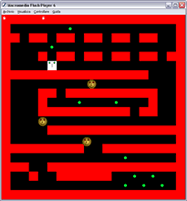
 |
 |
 |
 |
 |
 |
 |
 |
 |
 |
 |
  |
 |
||||||||||||
 |
|
|
|
 |
  DickDynamite: behind the scenes DickDynamite: behind the scenes[ June 21, 2003 ] by Marco Lapi, a.k.a Lapo This article is an overview on the features and the techniques employed in the making of "Dick Dynamite". Lapo also discusses the difficulties and the limits found working with Flash MX. Some of the complex topics touched in this article will be investigated in future articles. |
||||||||||||||||||||||||||
DickDynamite was born from some experiments using Flash MX at the beginning of spring 2002. My friend Bax and me just sat down in front of my PC, right after downloading the FlashMX trial, that was out by a bunch of days. The idea was to create a basic game prototype, based on the Pacman type arcades. It could take a whole day to understand what the hell was going on! Anyway, back in these days, we started out by creating a very simple 20x20 tiled map and two very ugly sprites, just to see how to make them move correctly in the map and detecting collisions.
Pic 1: this was one of the very early I thought that the best approach was to create a bi-dimensional array containing all of the tile data. When this part of the code worked we started thinking at a more flexible way of managing maps. map[0] = "XXXXXXXXXXXXXXXXXXXX"; map[1] = "X X"; map[2] = "XXXX XXXX XXX"; map[3] = "XX XX XX XXX XX"; map[4] = "XX XX XX XXX XX"; etc ........ map[19] = "XXXXXXXXXXXXXXXXXXXX"; A BETTER WAY OF MANAGING MAPS To create a better way of managing the levels we started thinking about using XML: <?xml version="1.0" encoding="iso-8859-1"?> <level> <name>DiamondQuest</name> <author>PiddU</author> <date>02/05/2003</date> <gigio posx="1" posy="1"/> <map> <mapline>QQQQQQQQQQQQQQQQQQQQ</mapline> <mapline>Q Q ccccc Q</mapline> <mapline>Q Q Q QQcQQQcQQcQ</mapline> <mapline>Q Q Q 0 Q</mapline> <mapline>QQ cQ cQ QQQ QQQ QQQ</mapline> <mapline>Qc Q Q 1 cQ</mapline> <mapline>QcQ Q QQcQQQ QQcQ</mapline> <mapline>Q 0 Q 1 cQ</mapline> <mapline>Q Q Q QQQcQQQcQQQ</mapline> <mapline>Q Q Q 1 Q</mapline> <mapline>QQ cQ cQ QQcQQQcQQ Q</mapline> <mapline>Q Q Q cccc cQ</mapline> <mapline>Q Q Q QQQcQQQ QQQ</mapline> <mapline>Q Q cQ</mapline> <mapline>Q Q Q Q Q Q QcQ</mapline> <mapline>Q$ Q0 Qc Qc Qc Q0 QQ</mapline> <mapline>QQ Q Q Q Q Q cQ</mapline> <mapline>Q Q QQ</mapline> <mapline>QQc QccQccQccQccQ6cQ</mapline> <mapline>QQQQQQQQQQQQQQQQQQQQ</mapline> </map> <backGround>8</backGround> <enemies> <enemy typ="3" speed="18" posx="16" posy="17"/> <enemy typ="3" speed="14" posx="3" posy="18"/> <enemy typ="3" speed="16" posx="18" posy="1"/> </enemies> </level> The map is contained in the <map></map> tags, and each <mapline></mapline> is one row of the map. (continues on page 2) |
||||||||||||||||||||||||||




|
||||||||||||||||||||||||||
|

